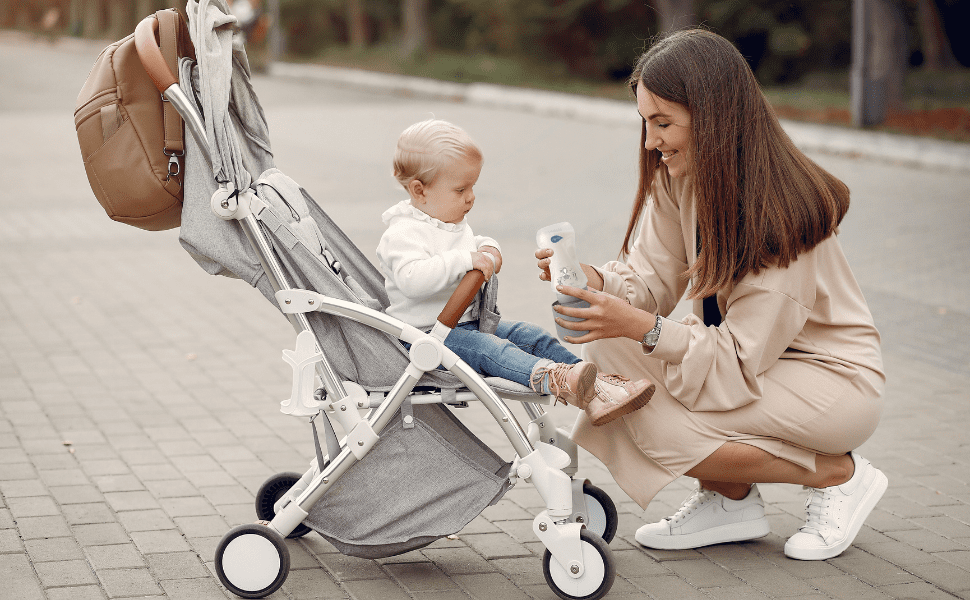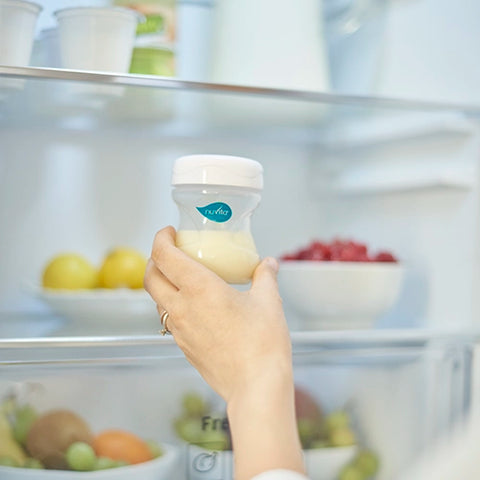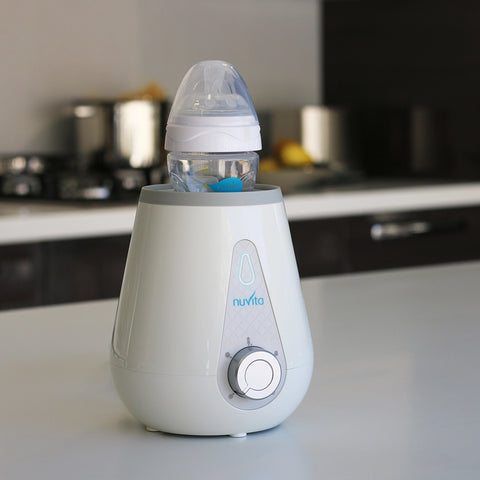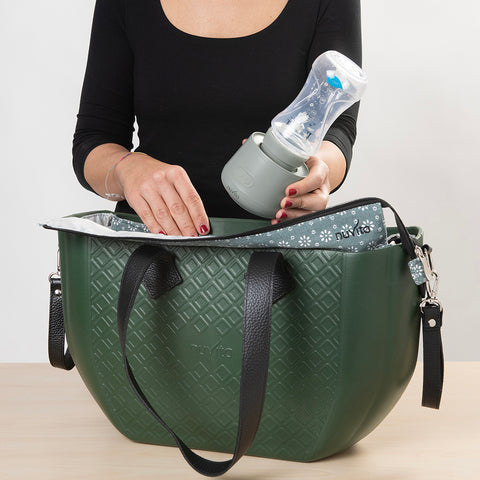How to prepare, store and heat milk when you are away from home

Practical advice and strategies for feeding babies and children during trips or days out
Feeding a child in the first months of life is one of the most delicate and fundamental aspects of infant care, and as long as you are in the privacy of your own home with all the comforts everything is simpler. It is different if you find yourself traveling by car, train or plane, or decide to spend a carefree day away from home with a child of breastfeeding age. If you are not breastfeeding, having to warm the bottle could become a logistical and practical challenge for many parents, but fortunately there are proven, effective and safe methods for warming both breast milk and formula even outside the home.
With a little organization and the right tools, you can ensure your baby gets his usual comfortable feeding regardless of where you are. Over time, each parent will develop tricks and methods that work better than others for their family; the important thing is to always keep the safety and well-being of the child as a priority.
The preparation
Before leaving home with your baby, good bottle preparation while maintaining high hygiene standards is essential for food safety.
It will therefore be necessary to have a well-cleaned and sanitized work surface, use well-washed and sterilized containers and wash your hands well before handling baby bottles or milk bags.
Breast Milk
Properties and Conservation of Breast Milk
Breast milk is a living food that contains antibodies, enzymes and other immune substances essential for the health and development of the newborn. Its conservation requires attention to keep these properties intact, especially when you plan to spend time outside the home. Fresh breast milk can be stored in glass bottles or pre-filled plastic bottles that convert into containers with screw-on travel caps .
At room temperature (not exceeding 25°C) it can be kept for a maximum of 4 hours; if, however, it is removed from the fridge it will be necessary to keep it cold until it is time to heat it. In this case a thermal bag with the classic frozen tile can preserve it for several hours.
If you use frozen breast milk stored in breast milk bags you will need to transfer it from the freezer to the fridge for at least 12 hours.
Never defrost breast milk in the microwave to avoid damaging its nutrients and never at room temperature to prevent it from degrading its nutrients.

Artificial Milk Powder
Properties and Conservation of Artificial Milk Powder
Infant formula , although it does not contain the same live elements as breast milk, must be prepared and stored following specific instructions to ensure its food safety.
The first rule is the correct temperature of the water when pouring the milk powder.
Why is it important that the water is first brought to 100°C, then cooled to 70°C before adding the milk powder?
Boxes and packages of powdered infant formula , even when sealed, may contain bacteria such as Enterobacter Sakazakii, which in some rare cases can cause serious infections. To reduce the risk of infection, water previously boiled and cooled to a temperature not lower than 70°C is used.
The temperature of 70°C is essential to eliminate most of the germs potentially present in powdered milk ; those that cannot be eliminated are however reduced to levels that are not dangerous for the infant's health.
In any case, it is not recommended to use water at a temperature higher than 70°C because the powdered milk could lose its nutrients.
Here is the correct procedure for preparing milk powder and reconstituting the formula:
- Wash your hands well.
- Bring the water to the boil at 100°C using, for example, a "classic" bottle warmer .
- Once boiled, let the water cool for 30 minutes, so that it reaches 70°C.
- Pour the water into the bottle and add the milk powder following the correct doses; each measure of milk must be level and not pressed.
If you have to leave or stay away from home for the feeding, preparing the bottle in advance ready to be heated only when needed can be a practical solution.
However, already reconstituted powdered infant formula must be stored in the fridge and consumed within 24 hours of its preparation. Once removed from the fridge, you can take it on a trip by keeping it in the fridge bag with ice pack for a maximum of 4 hours.
Reconstituted infant formula cannot be frozen.
The best recommended method, when possible, is always to prepare the bottle of powdered artificial milk at the moment.
Here is the correct procedure for preparing powdered milk and reconstituting the formula when you are away from home or traveling:
- Prepare the measured amount of milk powder in a small, clean, dry container.
- Place the water previously boiled and kept at 70°C in a container such as the Nuvita thermal bottle with thermometer
- Have a previously sterilized empty plastic or glass bottle with teat and cap
- At feeding time, just put the water in the bottle, add the powder and shake: the bottle of powdered artificial milk is ready in complete safety and convenience!
At room temperature, infant formula can be stored for a maximum of 2 hours; if the baby does not finish the bottle, the leftover milk should be thrown away and never heated a second time.
Liquid artificial milk
Liquid formula milk is a very practical solution; in fact, before opening, the package is sterile and the milk can be safely stored at room temperature.
The bottle must be freshly prepared and heated, and if the baby does not finish the bottle, the leftover milk should be thrown away and never heated a second time.
The opened package must be kept in the fridge and consumed in any case within 24 hours.
How to heat a bottle of milk outside the home: traditional methods
When you don't have access to appliances like a microwave, stove, or bottle warmer at home, warming milk for newborns can seem like a challenge. However, there are safe and practical methods that parents can use to ensure that milk is at the appropriate temperature for their baby.
In many public places such as cafes and restaurants, parents can request hot water to warm the bottle ; it is generally accepted and many merchants are willing to assist parents with young children.
Otherwise, if you decide to be completely independent, here are all the possible solutions depending on the type of milk used to feed your baby.

How to heat breast milk or already reconstituted powdered formula or liquid formula when you are away from home and without appliances?
If you use infant formula, keeping the water at a suitable temperature for preparing the formula is crucial. One solution is to bring along a thermos with already hot water which will allow you to quickly prepare the bottle when feeding time.
The most convenient and fastest way to heat bottles of milk outside the home and while traveling is to use a portable bottle warmer.
Fortunately, there are portable bottle warmers on the market that can be a valuable resource for traveling parents and connect to the car's cigarette lighter socket; others work with batteries, so you can heat milk in any traveling situation without needing any power socket.
For example, a home/car bottle warmer can be used both at home with a power socket but also in the car with its adapter included. It is compatible with all bottle models of all brands and baby food jars and is excellent for defrosting and heating all types of milk. It heats formula milk and baby food in just 2 minutes and 50 seconds and, with a more gradual method, breast milk. With just one product, 2 uses.
If you instead want maximum freedom and convenience, the most recent model of portable bottle warmer has a rechargeable battery and is very light enough to always carry in your bag for any type of trip or situation to warm the bottle on the train, on the plane, in the park, on the beach, at the restaurant: it's Warm'n'go . Compatible with all the best-selling brands of baby bottles, it already includes all the necessary adapters inside the package and is also suitable for glass bottles.

It heats breast milk, formula or water in 4 minutes and has a heating autonomy of up to 8 bottles with just 1 refill, covering the needs of all the feedings for a day away from home.
The heating part and the interior are also easily sterilizable with the Nuvita Mellyplus portable UV sterilizer .
Checking the temperature of the bottle
Before giving milk, it is essential to check its temperature: the ideal temperature for a small child is similar to body temperature, i.e. around 37°C.
The method to check if the milk bottle is at the correct temperature is very simple: just pour a few drops on your wrist. The milk must be warm to the touch but not boiling; in this way you will avoid burning the little one.
Traveling with children, even the youngest ones, or spending a whole day away from home, must always be a safe, well-being experience for them and not a source of stress. For parents, knowing how to organize themselves with the right accessories will simplify life and make everything lighter, leaving room only for enjoying quality time with their children.





